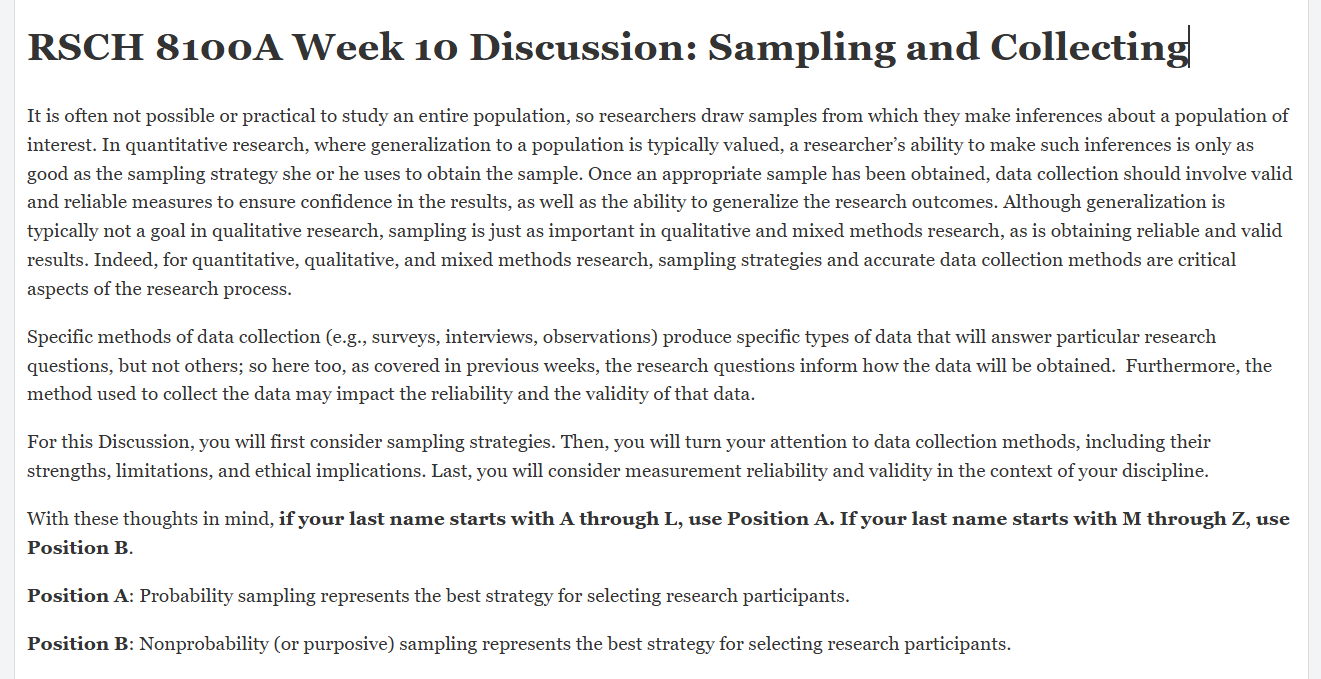RSCH 8100A Week 10 Discussion: Sampling and Collecting
It is often not possible or practical to study an entire population, so researchers draw samples from which they make inferences about a population of interest. In quantitative research, where generalization to a population is typically valued, a researcher’s ability to make such inferences is only as good as the sampling strategy she or he uses to obtain the sample. Once an appropriate sample has been obtained, data collection should involve valid and reliable measures to ensure confidence in the results, as well as the ability to generalize the research outcomes. Although generalization is typically not a goal in qualitative research, sampling is just as important in qualitative and mixed methods research, as is obtaining reliable and valid results. Indeed, for quantitative, qualitative, and mixed methods research, sampling strategies and accurate data collection methods are critical aspects of the research process.
Specific methods of data collection (e.g., surveys, interviews, observations) produce specific types of data that will answer particular research questions, but not others; so here too, as covered in previous weeks, the research questions inform how the data will be obtained. Furthermore, the method used to collect the data may impact the reliability and the validity of that data.
For this Discussion, you will first consider sampling strategies. Then, you will turn your attention to data collection methods, including their strengths, limitations, and ethical implications. Last, you will consider measurement reliability and validity in the context of your discipline.
With these thoughts in mind, if your last name starts with A through L, use Position A. If your last name starts with M through Z, use Position B.
Position A: Probability sampling represents the best strategy for selecting research participants.
Position B: Nonprobability (or purposive) sampling represents the best strategy for selecting research participants.
Resources
Be sure to review the Learning Resources before completing this activity.
Click the weekly resources link to access the resources.
WEEKLY RESOURCES
By Day 4
Post a restatement of your assigned position on sampling strategies. Explain why this position is the best strategy for selecting research participants. Support your explanation with an example and support from the scholarly literature. Next, select a data collection method (e.g., surveys, interviews, observations) and briefly explain at least one strength and at least one limitation. Then, identify a potential ethical issue with this method and describe a strategy to address it. Last, explain the relationship between measurement reliability and measurement validity using an example from your discipline.
Be sure to support your Main Issue Post and Response Post with reference to the week’s Learning Resources and other scholarly evidence in APA Style.
Read a selection of your classmates’ postings.
By Day 6
Respond to a classmate who was assigned the opposite position by further supporting or respectfully countering his or her position.
Note: For this Discussion, you are required to complete your initial post before you will be able to view and respond to your colleagues’ postings. Begin by clicking on the Reply button to complete your initial post. Remember, once you click on Post Reply, you cannot delete or edit your own posts and you cannot post anonymously. Please check your post carefully before clicking on Post Reply!
SOLUTION RSCH 8100A Week 10 Discussion: Sampling and Collecting
Hello Class,
Position A: Probability sampling represents the best strategy for selecting research participants.
Probability sampling is widely regarded as the most reliable strategy for selecting research participants, particularly in health research, due to its capacity to ensure representativeness and minimize selection bias (Etikan et al., 2016). By selecting participants at random from a larger population, probability sampling provides every individual an equal chance of inclusion. This is beneficial for producing generalizable results, as it ensures the study sample accurately mirrors the broader population, a critical aspect when findings are expected to inform healthcare policies or interventions (Taherdoost, 2016)….
Kindly click the purchase icon below to buy the full solution at $5
(FINAL ANSWER) RSCH 8100A Week 10 Assignment: Annotated Bibliography

